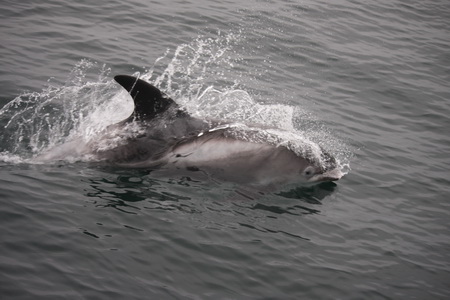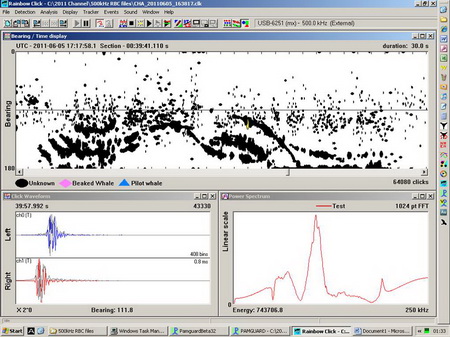With 3 new team members and fine weather conditions expected for the next few days we head out of Cherbourg in the sunshine – expectations of sightings and detections high in this second survey block. As we approach the beginning of our transect line by the Cap de Hague, the currents and tides around the boat are wild with swirling eddies and standing waves all around. The skies throughout much of the first few hours are filled with gannets in groups of 2 to 30 parading in lines above the swirling sea surface. As we cross the Channel the seas calm further and by midnight we are surrounded by glassy seas and a crescent moon over Portland Bill.
The wild currents and eddies continue as we approach the Casquets and through the Ortac Channel, named for a rock which is a roost for many gannets. The tide runs fiercely here at springs and the sea is a dramatic sight, with large groups of feeding seabirds. Later, en route to Jersey we have our first turtle sighting of a small Loggerhead swimming close to the vessel. As we approach the north coast of Jersey, for a while it was possible to imagine the islands were in the Mediterranean, not the Channel.
We are not so lucky the next day with misty and rainy weather as we pass close to the Channel Islands of Sark, Guernsey and Herm. Unfortunately, the weather does not improve during the day, making it impossible to observe constantly from the A-Frame. But as we arrive near to the English coastline once more, the sea is mirror calm. As we approach Lyme Bay, we have our first cetacean sighting of the second leg – around 5-8 white-beaked dolphins bow-riding for quite a while with at least one juvenile. The whole crew were excited by this sighting and we try to photograph the dolphins for later photo-identification. White-beaked dolphins, like other dolphins, can be recognised individually due to the marks on their dorsal fins including nicks, scars and teeth marks. We will compare these photos to already existing photo catalogues of the dolphins in this area to see if there were any matches. Additionally with our towed arrays in the water at the time, we record some amazing buzzing sequences from the dolphins and looking back over their click trains it is possible to see their swimming patterns from the noises they were making.
Mat, the Engineer, has concerns about an oil seal on the main engine so at the end of the next track line we head into Plymouth so that he can investigate further.


Sorry, comments are closed for this post.